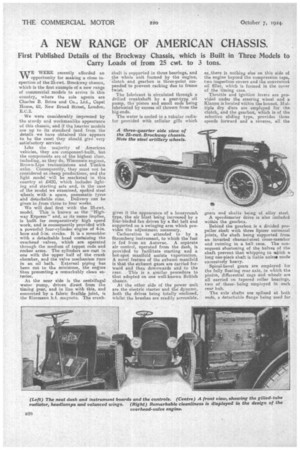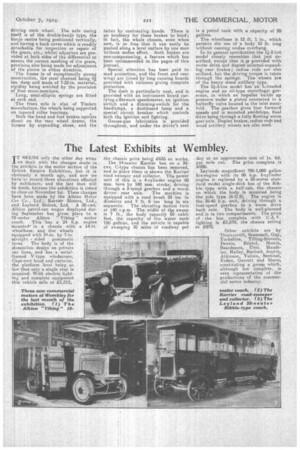A NEW RANGE OF AMERICAN CHASSIS.
Page 10

Page 11

If you've noticed an error in this article please click here to report it so we can fix it.
First Published Details of the Brockway Chassis, which is Built in Three Models to Carry Loads of from 25 cwt. to 3 tons.
'WE WERE recently afforded an opportunity for making a close inspection of the 25-cwt. Brockway chassis, which is the first example of a new range of commercial models to arrive in this country, where the sole agents are Charles B. Brine and Co., Ltd., Cape! House, 62, New Broad Street, London, E. C.2.
We were considerably impressed by the sturdy and workmanlike appearance of this chassis, and if the heavier models are up to its standard {and from the details we have obtained this appears to be the case) they should give very satisfactory service.
Like the majority of American vehicles, they are component-built, but the components are of the highest class, including, as they do, Wisconsin engines, Brown-Lipe transmissions and Timkin axles. Consequently, they must not be considered as cheap productions, and the light model will be marketed in this country at .420, which includes lighting and starting sets and, in the case of the model we examined, spoked steel wheels with a spare, pneumatic tyres arid detachable rims. Delivery can be given in „from three to tour Weeks.
We will deal first with the 25-cwt. model. This is known as the "Highway Express" and, as its name implies, is built for comparatively high speed work, and is consequently provided with a powerful four-cylinder engine of 4-in. bore and 5-in. stroke. It is a menobloc with a detachable head containing the overhead valves, which are operated through the medium of tappet rods and rocker arms, The cylinders are cast in one with, the upper half of the crank chamber, and the valve mechanism inns in an, oil bath. External piping has been cut to the minimum, the engine thus presenting a remarkably clean exterior.
At the near side is the centrifugal water pump, driven direct from the Liming gear, and in line with this, and connected by a fabric flexilaJe joint, Is the Eisemann h.t. magneto.. The crank
shaft is supported in three bearings, and the whole unit formed by the engine, clutch and gearbox is three-point suspended to prevent racking due to frame twist.
The lubricant is circulated through a drilled crankshaft by a gear-type oil Pump, the piston and small ends 'being lubricated by excess oil thrown from the big-ends.
The water is cooled in a tubular radiator provided with cellular gills which gives it the appearance of a honeycomb type, the air blast being increased by a lour-bladed fan driven by a flat belt and supported on a swinging arm which provides the adjustment necessary.
Carburation is attended to by a Stromberg instrament, to which the fuel is. fed from an Autovac. A separate air control, operated from the dash, is provided to facilitate starting and a bat-spot manifold assists vaporization. A. novel feat sire of the exhaust manifold is that the exhaust gases are carried forward and then downwards and to the rear. This is a, similar procedure to that adopted on one well-known British chassis.
At the other side of the power unit are the electric starter and the dynamo, both the drives being totally enclosed, whilst the brushes are readily accessible,
as jliere is nothing else on this side of the engine beyond the compression taps, two inspection covers and the convenient oil filler, which is formed in the cover of the timing case.
Throttle and ignition levers are provided under the steering wheel and a Klaxon is located within the bonnet. Multiple dry discs are employed for the clutch, and the gearbox, which is of the selective sliding type, provides three speeds forward and a reverse, all the gears and shells being of alloy steel. A speedometer drive is also included within the gearbox.
Rebirth the gearbox is a divided propeller shaft with three Spicer universal joints, tile shaft being supported from an inverted channel-steel Cross-member and running in a ball race. The consequent shortening of the halves of the abaft prevent that whipping to which a long one-piece shaft is liable unless made excessively heavy. Spiral-bevel gears are employed for the fully coating rear axle, in which the pinion, differential cage and wheels are all carried on tapered roller bearings, two of these-being employed in each rear huh.
The axle shafts are splined at both ends, a detachable flange being used for
driving each wheel. The axle casing itself is of the double-banjo type, the banjo centre being positioned vertically, and having a back cover which is readily detachable for inspection or repair of the gears, etc., whilst adjusters are provided at both sides of the differential to ensure the correct meshing of the gears, provision also being made for adjustment . of the pinion in either direction.
The frame is of exceptionally strong construction, the steel channel being 4g ins, deep and made of 7-32-in. material, rigidity being assisted by the provision of four cross-members, Long, semi-elliptic springs are fitted at each end.
The front axle is also of Timken manufacture, the wheels being supported on tapered roller bearings.
Both the hand and foot brakes operate direct. on the rear wheel drums, the former by expanding shoes, and the
latter by contracting bands. There is no tendency for these brakes to bind; in fact, the whole chassis, even when new, is so free that it can easily be pushed along a level surface by one man without undue effort. Both brakes are non-compensating, a feature which has been recommended in the pages of this journal.
Special attention has been paid to mud protection, and the front and rear wings are joined by long running boards provided with valances giving complete protection.
The dash is particularly neat, and is provided with an instrument board carrying a Stewart. speedometer, an ignition switch and a dimming-switch for the headlamps, a dashboard lamp and a. special circuit breaker which controls both the ignition and lighting.
Grease-gun lubrication is provided throughout, and under the driver's seat
is a petrol tank with a capacity of 20 gallons.
The wheelbase is 12 ft. 1 in., which permits the use of a body 10 ft. long -without causing undue overhang.
In its general specification the 11-2-ton model closely resembles that just described, except that it is provided with worm drive and duplex internal-expandfog rear brakes; radius rods are also utilized, but the driving torque is taken through the springs. The wheels are of the heavy wood artillery type. The 24-3-ton model has an L-headed engine and an oil-type centrifugal governor, in which an impeller builds up pressure under a pistou connected to a butterfly valve located in the inlet manifold. The gearbox gives four forward speeds and is mounted amidships, final drive being through a. fully floating worm gear axle. Duplex brakes, radius rods and wood artillery wheels are also used.






























